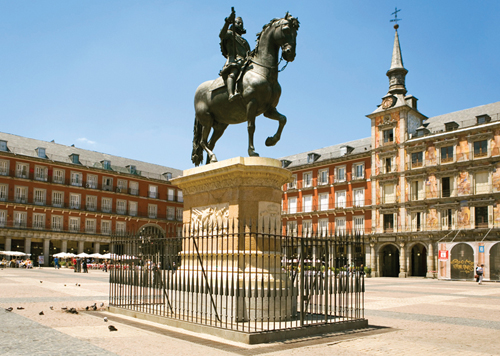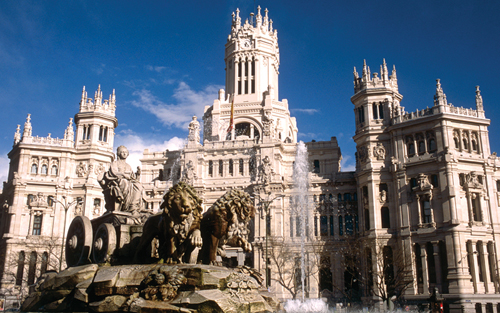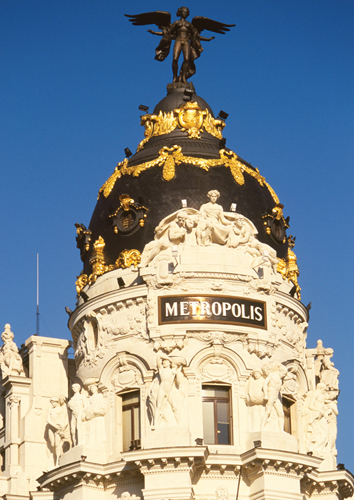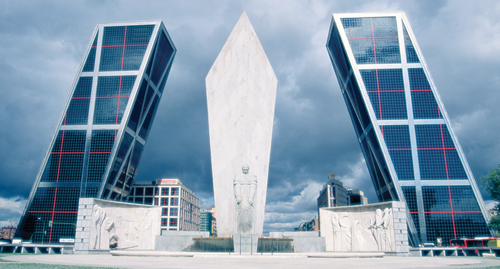Palacio Real The
Royal Palace marks a decisive break with the austere tastes of Spain’s
Habsburg rulers. Felipe V had been brought up at Versailles where the
International Baroque style was in vogue. Architect Filippo Juvara died
two years into the project, but his successor, Gian Battista Sacchetti
retained the Baroque spirit .

Palacio Real
Plaza Mayor The inspiration for the square was El Escorial’s courtyard. But the plans of architect Juan de Herrera were only realized 30 years in 1619 later by Gómez de Mora .

Plaza Mayor
Palacio de Comunicaciones Home
of the Madrid Town Hall from 2007, this extraordinary building was the
first major commission of Galician architect Antonio Palacios and his
partner, Joaquín Otamendi. The style of this palace (1905–19) has
influences ranging from Spanish Plateresque to Art Deco. The most
striking feature of the interior is the stained-glass roof.

Palacio Longoria Art
Nouveau is usually associated with Barcelona rather than Madrid and, in
fact, this superb example is by the Catalan architect José Grases
Riera. Bold and original in design, take a close look at the florid
sculptural detail, the sensuous curves and the balustrade – all typical
Art Nouveau features . Círculo de Bellas Artes The
Fine Arts Club dates from the 1920s and is Antonio Palacios’ Art Deco
masterpiece. The crowning feature is the statue on the roof,
representing the goddess Minerva, patroness of the arts. Pay the one day
membership fee and you can take in the other highlights – the
staircase, theatre, ballroom and the Salón de Fiestas, with its painted
ceiling . Metrópolis One
of Madrid’s signature buildings, Metrópolis was designed in 1905 by the
French architects Jules and Raymond Février. The high point literally
of this lovely Neo-Baroque confection is the bronze wreaths garlanding
the cupola, which glint in the sunlight .

Metrópolis cupola
Iglesia de San Jerónimo el Real Though
much altered over the years, this 16th-century church is an important
architectural monument. It has also been a place of refuge for Spanish
kings and queens through the ages. The current king, Juan Carlos I, was
crowned here in 1975 . Residencia de Estudiantes Founded
in 1910 as a liberal college, early alumni here included artist
Salvador Dalí and poet Federico García Lorca. Designed by Antonio
Flórez, the main building was nicknamed “transatlantic” by students
because the balustrade resembled the rail of an ocean liner. Torre Picasso The
tower’s main claim to fame is that, at 157 m (515 ft), it is the
tallest building in Madrid. Opened in 1989, it is the work of Japanese
architect Minoru Yamasaki, designer of the ill fated World Trade Center
in New York. Puerta de Europa The
“Gateway to Europe” is a modern version of a triumphal arch. Twenty-six
storeys high, the leaning towers of glass and metal were completed in
1996. Plaza de Castilla Metro Plaza de Castilla

Puerta de Europa
Top 10 Places to See Azulejos Tiles
Las Fatigas Del Querer The interior of this 1920’s tavern is decorated with Andalusian tiles and murals. Taberna la Dolores Tiled mosaics adorn the façade of this taberna dating from 1908 . Viva Madrid Tiled inside and out; look for the Cibeles fountain on the façade . Villa Rosa Fantastic ceramic decor dates from the days when this bar was a flamenco club. Antigua Huevería and Farmacia Juansé Two
tiled frontages. The pharmacy advertised “inoffensive cigarettes”,
while the painted hens next door are a clue that this bar was once an
egg shop (huevería). Bodega de Angel Sierra Stunning tiled façade and interior, dating from the early 20th century . Fábrica de Churros Pop inside this shop and check out the traditional tiled interior . La Fontana de Oro Pretty old café converted into a Guinness pub. La Quinta del Sordo The tiled façade here features scenes from Goya’s paintings. Taberna la Daniela Ceramic motifs cover the bar and façade of this classic Madrid taberna .
|